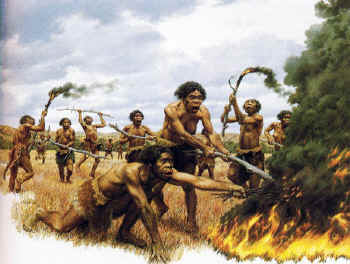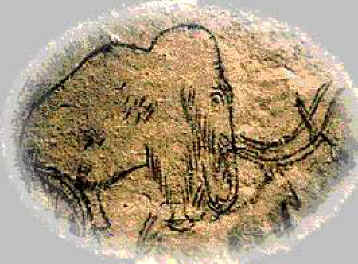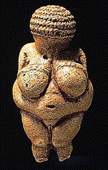08.12.2000.
Earth - Geological Time Scale |

Homo Erectus learns how to use fire
|

Mammoth drawed on the Cave wall |

Willendorf Venus |
| This geological
time scale outlines the development of the earth and of life on the earth. The earth's
earliest history appears at the bottom of the chart, and its most recent history is at the
top. |
Period or epoch
and its length |
Beginning
(years ago) |
Development of life
on the earth |
Cenozoic
Era |
Quaternary
Period |
Holocene Epoch
10 thousand years |
10 thousand |
Human beings hunted and tamed
animal; developed agriculture; learned to use metals, coal, oil, gas and other resources,
and put the power of wind and rivers to work. |
Cultivated plants |
Pleistocene Epoch
2 million years |
2 million |
Modern human beings developed.
Mammoths, woolly rhinos and other animals flourished but died out near the end of the
epoch. |
Human beings |
Tertiary
Period |
Pliocene Epoch
3 million years |
5 million |
Sea life became much like
today's. Birds and many mammals became like modern kinds and spread around the world.
Humanlike creatures appeared. |
Horses |
Miocene Epoch
19 million years |
24 million |
Apes appeared in Asia and
Africa. Other animals included bats, monkeys, whales, primitive bears and racoons.
Flowering plants and trees resembled modern kinds. |
Apes |
Oligocene Epoch
14 million years |
38 million |
Primitive apes appeared. Camels,
cats, dogs, elephants, horses, rhinos and rodents developed. Huge rhinoceroslike animals
disappeared near the end of the epoch. |
Early horses |
Eocene Epoch
17 million years |
55 million |
Birds, amphibians, small
reptiles and fish were plentiful. Primitive bats, camels, cats, horses, monkeys,
rhinoceroses and whales appeared. |
Grasses |
Paleocene Epoch
8 million years |
63 million |
Flowering plants appeared.
Invertebrates, fish, amphibians, reptiles and mammals were common. |
Small mammals |
Mesozoic
Era |
|
Cretaceous Period
75 million years |
138 million |
Flowering plants appeared.
Invertebrates, fish and amphibians were plentiful. Dinosaurs with horns and armor became
common. Dinosaurs died out at the end of the period. |
Flowering plants |
| |
Jurassic Period
67 million years |
205 million |
Cone-bearing trees were
plentiful. Sea life included shelled squid. Dinosaurs reached their largest size. The
first birds appeared. Mammals were small and primitive. |
Birds |
| |
Triassic Period
35 million years |
240 million |
Cone-bearing trees were
plentiful. Many fish resembled modern kinds. Insects were plentiful. The first turtles,
crocodiles and dinosaurs appeared, as did the first mammals. |
Dinosaurs |
Paleozoic
Era |
|
Permian Period
50 million years |
290 million |
The first seed plants -
cone-bearing trees - appeared. Fish, amphibians and reptiles were plentiful. |
Seed plants |
Carboniferous
Period |
Pennsylvanian Period
40 million years |
330 million |
Scale trees, ferns and giant
scouring rushes were abundant. Fish and amphibians were plentiful. The first reptiles
appeared. Giant insects lived in forests where coal later formed. |
Reptiles |
Mississippian Period
30 million years |
360 million |
Trilobites had nearly died out.
Crustaceans, fish and amphibians were plentiful. Many coral reefs were formed. |
Amphibians |
| |
Devonian Period
50 million years |
410 million |
The first forests grew in
swamps. Many kinds of fish, including sharks, armored fish and lungfish, swam in the sea
and in fresh waters. The first amphibians and insects appeared. |
Fish |
| |
Silurian Period
25 million years |
435 million |
Spore-bearing land plants
appeared. Trilobites and mollusks were common. Coral reefs formed. |
Corals |
| |
Ordovician Period
65 million years |
500 million |
Trilobites, corals and mollusks
were common. Tiny animals called graptolites lived in branching colonies (groups). |
Graptolites |
| |
Cambrian Period
70 million years |
570 million (?) |
Fossils were plentiful for the
first time. Shelled animals called trilobites and some mollusks were common in the sea.
Jawless fish appeared. |
Trilobites |
Precambrian
Time
Almost 4 billion years (?) |
4.5 billion (?) |
Coral, jellyfish and worms lived
in the sea about 1,100 million years ago. Bacteria lived as long as 3.5 billion years.
Before that, no living things are known |
Bacteria |


